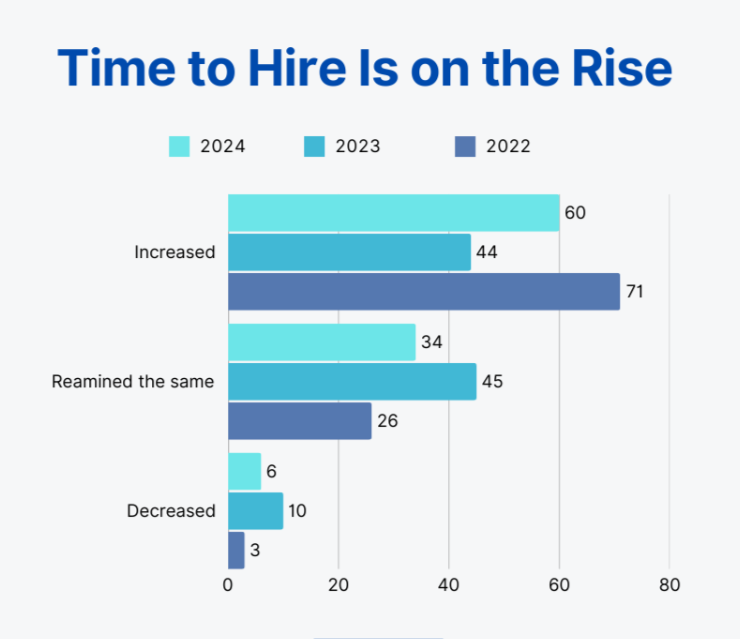Hiring in today’s market feels like steering a leaky boat through a storm. Despite your best efforts, you’re losing talent, time, and momentum.
The landscape is as competitive as it is chaotic. Job boards are saturated, applicant pools are unqualified, and internal teams are engrossed with managing bottlenecks instead of building pipelines. Whether you’re trying to fill a critical role or scale fast, you’re likely facing staffing challenges that feel more structural than situational.
And here’s the kicker: it’s not your fault. The market has evolved, and most hiring systems weren’t built for this market.
That’s why many companies now rely on staffing agencies to solve deeper hiring problems, not just open positions.
Let’s walk through the real hiring challenges holding businesses back and how staffing agency solutions are turning those pain points into growth opportunities.
Common Hiring Challenges Businesses Face
Hiring has become harder, despite teams trying their best. At its core, the struggle comes down to three issues: access, speed, and fit.
1. Skill shortages in critical roles
The demand for niche talent has outpaced supply in IT, healthcare, and manufacturing sectors. Even with aggressive job postings, inbound applications often miss the mark. More than a labor shortage, it’s a shortage of qualified, well-matched candidates.
2. Increased time to hire
Extended hiring timelines cost more than just time by increasing the risk of losing top candidates and overburdening existing teams. For roles that demand speed, this delay can be a competitive disadvantage.

3. Poor quality of hires
Misaligned sourcing, rushed assessments, or reactive hiring can lead to mismatches. And mismatches don’t just affect productivity. They also spike turnover, kill morale, and damage the employer brand.
4. Internal bottlenecks
Too many stakeholders, inefficient processes, or outdated applicant tracking systems slow things down. Add over-reliance on internal HR teams already stretched thin, and hiring stalls.
5. Hiring process problems in volume hiring
Hiring at scale? Multiply every challenge above. Volume hiring introduces its own staffing challenges, like high rejection rates, inconsistent candidate experience, and unscalable workflows.
Each of these issues isn’t isolated. They compound, and without intervention, they impact business outcomes.
How Staffing Agencies Address These Challenges
Top staffing agencies react to hiring challenges and also preempt them with systems, data, and reach that most in-house teams can’t match. Here’s how:
1. Strategic staffing solutions for hard-to-fill roles
Agencies have industry-specific recruiters who specialize in building and maintaining deep talent pipelines. They know where the candidates are, how to engage them, and what it takes to close. When it comes to addressing skill shortages, staffing agency solutions rely on active talent pools, referral networks, and AI-driven sourcing tools and not job board roulette.
2. Reducing time to hire without cutting corners
Most agencies shorten time to hire by 40–60%, depending on the role. They manage sourcing, screening, assessments, and pre-interviews, compressing weeks of work into days. This also means candidates enter your pipeline already qualified and aligned.
3. Improving quality through rigorous vetting
The best staffing partners bring more than resumes. They bring tested candidates. Through pre-employment testing, structured interviews, and behavioral vetting, agencies consistently improve the quality of hire and reduce the risk of turnover.
4. Scaling without breaking internal systems
When the need for talent spikes, agencies scale fast. Whether you need 1 candidate or 100, they offer workflows that integrate seamlessly with your team. No internal system rebuilds, no extra overhead, just plug-and-play hiring.
5. Compliance and Candidate Experience
Top staffing agencies focus on all aspects of hiring, including compliance, onboarding, and experience. This ensures every candidate touchpoint is aligned with your brand and every placement is legally airtight.
The takeaway? Staffing agencies aren’t a last-ditch option but a proactive hiring strategy.
And Here’s Proof This Works?
A global biopharmaceutical company faced urgent workforce challenges across two U.S. sites. Pandemic-driven delays, shifting timelines, and a critical need for skilled talent put pressure on internal teams. They didn’t just need resumes, they needed results.
That’s when they partnered with SPECTRAFORCE.
Through a strategic Vendor on Premise (VOP) model, SPECTRAFORCE designed a hiring approach that aligned with the client’s production milestones. Despite a four-month site shutdown and compressed timelines, the agency placed over 1,900 workers and converted 830+ into full-time employees , all while maintaining quality and speed.
This was about building workforce resilience, adapting fast, and delivering measurable outcomes under pressure.If your hiring process feels stuck or stretched thin, the right staffing partner can move the needle, and move it fast.
Know more about staffing solutions with their types, benefits, and best practices in our detailed blog here.
So, Should You Consider a Staffing Partner?
You may think that engaging a staffing agency helps you outsource your problems. What it actually does is amplify your strengths. Qualified staffing agencies become your partners in the process. They bring in innovative approaches to staffing to extend your team’s reach, precision, and agility, helping you hire faster, smarter, and with fewer chances of errors.
Knowing when to lean in can be the difference between reactive recruitment and a future-proof talent strategy.
Here’s when it makes strategic sense:
- When roles remain open past 30 days and your internal team is stretched thin.
- When you’re entering new markets or launching new teams and need localized hiring intelligence.
- When you’re scaling fast and can’t afford hiring delays or misfires.
- When you’re hiring for specialized or confidential positions where discretion and niche expertise matter.
- When turnover is spiking and you need to stabilize teams with better hiring fits.
Conclusion: The Cost of Inaction Is Higher Than You Think
Here’s the truth: every hiring delay, every misfit hire, and every candidate dropout is a cost — not just to your headcount, but to your growth, culture, and credibility. Businesses that treat hiring as a strategic function outperform those who don’t. And staffing agencies? They’re built for this.
But not all staffing agencies are equal. The right partner understands your industry and your unique hiring needs. Your pace, your priorities, and your people.
So if your hiring feels like it’s stuck on repeat, don’t settle for tweaks. Rethink the model. A strategic staffing partner can turn your hiring process from a pain point into a performance driver.
Struggling to fill critical roles or just tired of hiring on repeat? Let’s solve your recruitment challenges together. Book a quick discovery call with SPECTRAFORCE and find out how our staffing solutions can get you back on track.
FAQs
1. How do staffing agencies address skill shortages in specific industries?
Staffing agencies maintain segmented, continuously updated talent pipelines for high-demand industries such as tech, healthcare, finance, and manufacturing. These pipelines include both active job seekers and passive candidates( i.e, professionals not actively applying but open to opportunities).
They also deploy targeted sourcing strategies using niche platforms, referrals, and AI-based resume matching to uncover talent your internal team might miss. For especially hard-to-source roles, agencies may also assist with upskilling programs or recommend contract-to-hire models to test candidate fit.
2. Can staffing agencies help reduce employee turnover rates?
Yes, significantly. One of the biggest contributors to turnover is poor job-to-candidate fit. Staffing agencies mitigate this through deeper pre-hire assessments, structured interviews, and behavioral or cultural fit evaluations.
Agencies often have access to historical placement data that helps predict long-term success. In contract or temp-to-perm placements, you also get the chance to evaluate performance before converting a hire, reducing the risk of a bad fit.
3. What strategies do staffing agencies use to attract top talent?
Leading agencies invest in employer branding strategies that go beyond posting ads. They craft compelling job narratives, highlight company culture, and personalize outreach based on candidate motivations.
Talent sourcing is done through multiple touchpoints including job boards, LinkedIn, alumni networks, and internal databases. Many agencies also run passive candidate marketing campaigns and leverage AI tools to retarget quality leads over time. It’s not just about reach but resonance.
4. How can staffing agencies help with hard-to-fill roles?
Hard-to-fill roles are typically plagued by low supply or highly specific requirements. Staffing agencies bring speed and specialization by tapping into niche communities, building relationships with passive candidates, and pre-qualifying talent before they reach your desk.
Many also consult on compensation benchmarks, role design, and market perception to help make your offer more competitive. Their advantage lies in knowing where and how to look when conventional sourcing fails.
5. Are staffing agencies cost-effective for small businesses?
Yes, and in many cases, they’re more cost-effective than building an in-house team for sporadic hiring needs. For small businesses, unfilled roles mean missed revenue, delayed projects, or burnout among existing employees.
A staffing agency helps minimize those costs by reducing time to hire and increasing the odds of a successful placement. Many agencies also offer flexible fee structures, including success-based models or tiered services tailored to smaller budgets and leaner ops teams.



